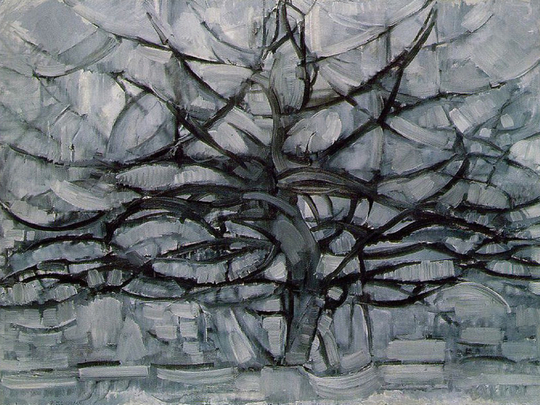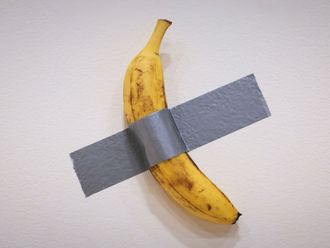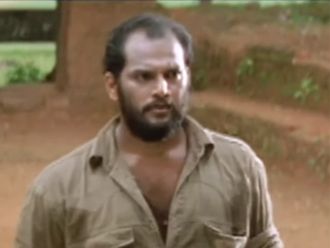
Is it a skull or a flower? The rounded white shape that sags on a listless stem in the painting is the dying bloom of a chrysanthemum, yet it eerily resembles a human head stripped to the bone. A ghostly eye socket seems to peer out of it. What can Piet Mondrian have been thinking when he painted this morbid image called Metamorphosis in 1908?
It is a decadent bloom of late Romanticism, passionate and inward-looking and completely out of time. When Mondrian completed it, Matisse was the talk of Paris and Picasso had blown up artistic tradition with his 1907 masterpiece Les Demoiselles d’Avignon. In Amsterdam, however, the aesthetic ideals of the 19th century were alive and well. The 36-year-old Mondrian was painting what the conservative local art market wanted — flowers and windmills, sunsets and farmhouses. No one could have predicted he would die an avant-garde hero in New York in 1944 and be remembered in the 21st century as one of the greatest of all modern artists.
What’s in a date? This is a centenary year of the modern world. In 1917 the October Revolution transformed geopolitics and Marcel Duchamp sent a porcelain urinal to an art exhibition — but in the Hague they are celebrating another 100th birthday, that of De Stijl (pronounced, and meaning, “style”), the movement in which Mondrian, Theo van Doesburg, Gerrit Rietveld and other Dutch artists and architects set out to transform the world with pure geometric design and unadulterated primary colours.
Piet Mondrian, Mill in Sunlight
Those reds, blues and yellows make a De Stijl birthday party of the Hague’s skyline as public buildings sport giant Mondrian decorations. Meanwhile the city’s Gemeentemuseum is about to open its biggest ever display of Mondrian’s art. Yet this fascinating exhibition subverts its own premise. Far from pivoting on the revolutionary year 1917, it shows that Mondrian’s abstract vision has deeper roots: like the dying flower he painted in 1908, it grew out of the fetid soil of the 19th century.
Pieter Cornelis Mondrian was born in 1872. George Eliot’s Middlemarch was being published in serial form. Mondrian was nearly a decade older than Picasso. He was in his 20s when Oscar Wilde was sent to Reading jail. Not only did he spend much of his life in the age of Queen Victoria, this exhibition shows how indelibly it shaped his art.
Victory Boogie Woogie
If you make a trip to the Hague anticipating room after room of black and white grids and bright planes of colour, you’ll be disappointed. One of the earliest paintings here is a carefully realistic dead hare that dates from 1891. It is part of this museum’s vast hoard of the artist’s early work. When he emigrated from the Netherlands for good in 1919, he left much of his previous output with his friend Salomon Slijper, who eventually bequeathed it to the Gemeentemuseum.
It may seem like a detour to look at all these paintings of almost parodically Dutch themes such as flowers and canals. But it is only by following Mondrian’s long and tortured artistic evolution that you can truly understand his courage and integrity. For he did not just wake up in 1917 and start painting coloured squares. His ideas developed gradually. His discovery of abstract art was the climax of a spiritual quest.
What we encounter here is a man searching for something beyond what the eye can see. That ghostly 1908 painting of a chrysanthemum is a clue. It is a florid symbol of life and death, decay and renewal: even as we die in this world, the soul survives on another plane. This spiritual yearning is expressed in a more mawkish way in another 1908 painting called Devotion that shows a girl piously contemplating a flower floating in space. A big work from 1911, Evolution, depicts three radiant beings like Easter Island statues. You can’t miss the mystical ambitions of these quasi-religious paintings.
Farmhouse With Wash on the Line
Mondrian was fascinated by theosophy, a spiritualist and occult movement founded in New York in 1875. Under their charismatic leader Madame Blavatsky, theosophists sought to discover “the unexplained laws of nature and the powers latent in man”. It grew out of Victorian spiritualism yet also went back to older belief systems like Neoplatonism, which preached the existence of a higher reality beyond the world we can see.
If it seems hard to take this stuff seriously as a source for great art, consider the works of William Blake. From the 1790s onwards Blake evolved his own mythology based on his rejection of common-sense reality. He drew the ghost of a flea from life. His art makes the invisible visible; so too does Mondrian’s. In the handful of his paintings that express theosophy directly, Mondrian seems a true eccentric. In more successful works, however, his mysticism is a fire that illuminates the Dutch landscape. His 1908 painting Mill in Sunlight is a rhapsodic vision. The windmill is bathed in red fire, the lemon sky specked with blue.
As he was painting this, Picasso was inventing cubism and his mindset seems remote from the tough analysis of the physical world that Picasso and his collaborator Georges Braque were pursuing in Paris. Mondrian went there at the start of 1912. His paintings suddenly lost their romantic colours. In 1912 he painted Flowering Apple Tree, a richly branching diagram through which pale leaf-shapes flow. It is as if he is painting the apple tree from the inside, sensing its true reality — painting it with his eyes closed and imagination open.
Picasso and Braque showed Mondrian how to see beyond the outer appearance of things. Ever since the Renaissance, the mission of western art had been to exactly picture reality. Cubism shattered that picture. For Mondrian it was a passport into the world he wanted to paint — the intuitive dimension of spirit. By 1914 he was painting Pier and Ocean 4, in which the shards and planes of cubism have rearranged themselves into a system of vertical and horizontal black lines criss-crossing in a pale void.
When Van Doesburg founded an avant-garde magazine called De Stijl in 1917, Mondrian wrote for it and shared ideas with fellow members of this defiant attempt to revolutionise the moribund culture of the Netherlands. The De Stijl group designed houses and furniture whose geometrical freedom would liberate the world. There is no more moving relic of the hope and audacity of early modernism than Rietveld’s De Stijl chair, with its uncomfortable wooden structure transfigured by bright paint. Who needs comfort when you’re headed into utopia?
Yet Mondrian had only returned to the Netherlands for the duration of the First World War. By 1919 he was back in Paris, keeping in touch with De Stijl by letter. His Paris studio, reconstructed at the Gemeentemuseum, was a visionary work of art in itself. Mondrian slept in a small monastic cubicle on the lower floor. Upstairs, his brightly daylit studio was a living Mondrian painting, its white walls decorated with coloured squares, its neat floorplan divided into carefully mapped working and thinking areas.
The paintings he created there are endless, boundless, timeless. Each of Mondrian’s mature canvases is a section of some larger reality whose dimensions appear infinite. Black lines speed off into space. Red, blue, yellow planes dance across whiteness. The Gemeentemuseum’s proudest exhibit is Victory Boogie Woogie, his last painting, done in New York after he fled Europe before the war. Sticky tape squares like yellow taxis dot a grid that merges utopia with the street plan of Manhattan.
What a journey his life was. The 19th-century artist who painted a still life of a hare became one of the great artistic definers of the modern world. This exhibition captures the scale of the revolution that took place within him. Yet the more you compare his early and late art, the more you see coloured rectangles in the humblest rural scene. In about 1896 the young Mondrian painted a row of clothes drying on a washing line in the Dutch countryside, in a work called Farmhouse With Wash on the Line. Flat shapes of white linen are suspended in space. Above them rises the red rectangle of a roof. It is an abstract scene. A new beauty is born on a quiet day in the country.
–Guardian News & Media Ltd
The Discovery of Mondrian will run at Gemeentemuseum, the Hague, Netherlands, until September 24.












